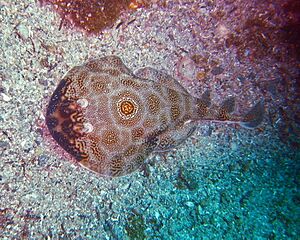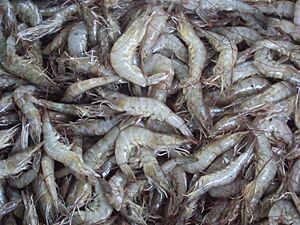Ocellated electric ray facts for kids
Quick facts for kids Ocellated electric ray |
|
|---|---|
 |
|
| Conservation status | |
| Scientific classification | |
 |
|
| Range of the ocellated electric ray | |
| Synonyms | |
|
Discopyge ommata D. S. Jordan & Gilbert, 1890 |
The ocellated electric ray or bullseye electric ray (Diplobatis ommata) is a type of electric ray. It lives in the shallow waters of the eastern central Pacific Ocean. You can find it from the Gulf of California all the way to Ecuador.
This ray can grow up to 25 cm (10 inches) long. It has a rounded body shape, like a disc. Its tail is short and thick, with two fins on top. The tail ends in a triangular fin. The ocellated electric ray gets its name from a large, special "eyespot" on its back. This spot has a black or yellow center. It is surrounded by rings, like a target. The rest of its body can be light or dark brown. It might have patterns or just be plain.
This ray is usually alone and active at night. It lives on the ocean floor in sandy or rocky areas. It moves by "hopping" on its fins. It eats small crustaceans and worms. To protect itself, it can create an electric shock. This species likely gives birth to live young. The International Union for Conservation of Nature (IUCN) says this ray is of "least concern." But it can be caught by accident in fishing nets.
Contents
About the Ocellated Electric Ray
The ocellated electric ray has a body shaped like a heart or a trowel. Its body disc is a bit wider than it is long. You can see two large, kidney-shaped electric organs through its skin. These are on either side of its head. Its small eyes are followed by even smaller holes called spiracles. These spiracles have small, rounded bumps on their edges.
The ray's snout is wide and round. Each nostril is split into two openings. There is a flap of skin between the nostrils. Its small mouth forms a straight line. The lower jaw is wavy and usually hides its teeth when closed. It has 14 to 16 rows of small, pointed teeth in each jaw. These teeth get longer and sharper towards the back of the mouth. There are five pairs of small gill slits on the underside of its body.
Fins and Skin
The ray's large pelvic fins start under its body. They have curved back edges. Adult males have very short, thick claspers. The tail is wide and flat. It is shorter than the body disc. It has a fold of skin along each side. There are two small fins on its back, called dorsal fins. Both have rounded or pointed tips. The first dorsal fin is a bit smaller than the second. Its position can vary. The tail fin, called the caudal fin, is triangular. It has rounded corners and is about the same size on top and bottom. The ray's skin is soft. It does not have any rough scales or bumps.
Colors and Patterns
The color of the ocellated electric ray's back can be very different from one ray to another. The only thing that stays the same is the big "eyespot" in the middle of its back. The center of this eyespot can be black or yellow. It is surrounded by rings that are dark and light. These rings can be solid or broken.
Most often, the rest of the ray's upper body is light brown. It has many tiny dark dots. It might also have light dots, bigger dark spots, or swirly brown patterns. Some rays are just plain light or dark brown with a black eyespot. The part of the body disc in front of the eyes is brown. It can have up to five darker blotches. The pattern on its back often goes down to the edges of its belly fins. The underside of the ray is usually white or cream-colored.
Where the Ray Lives
The ocellated electric ray is common in the warm coastal waters of the eastern Pacific. Its home range goes north to the Gulf of California and Bahía San Juanico in Baja California Sur. It goes south all the way to Ecuador.
This ray lives on the bottom of the ocean. It has been found from the shallow areas where the tide goes out to depths of 94 meters (308 feet). This ray likes sandy bays. But it can also be found on rocky areas or beds of special red algae.
Life and Habits
Like other electric rays, the ocellated electric ray can give a moderate electric shock. This is how it defends itself. During the day, this ray is usually alone. It spends most of its time partly buried in the sand. It often stays near rocky reefs.
It becomes more active at night. It uses its pelvic fins to "hop" along the sea floor. It eats small crustaceans like amphipods and shrimp. It also eats polychaete worms.
Reproduction
We don't know all the details about how this ray reproduces. But it is thought to give birth to live young. This is called viviparous reproduction. The baby rays probably get their first food from a yolk sac. Later, they get food from a special "uterine milk" made by the mother. This is how other electric rays reproduce.
Ray and Humans
The electric shock from the ocellated electric ray is not dangerous to people. Sometimes, these rays are kept in home aquariums. But they are hard to care for. They need to eat live invertebrates.
Ocellated electric rays and other electric rays are important for science. Scientists study their electric organs. These organs are full of special parts called ion channels and acetylcholine receptors. These parts are very important for the human nervous system. For example, a protein called agrin was first found in this species. Agrin helps build the human nervous system when a baby is developing.
This ray is not usually caught for food. But it is often caught by accident in shrimp fishing nets. This is called bycatch. We don't know exactly how many rays die from fishing. But it is thought to be a lot. This is because many Diplobatis species are caught in fishing nets in other areas. It is also hard to tell these rays apart, so the number caught might be even higher. Even with these concerns, the International Union for Conservation of Nature (IUCN) says this species is of "least concern." This is because it is still common in its habitat.



